by Rowan Johnson
In the 1950s, Leonard Cohen often walked a long road home from Congregation Shaar Hashomayim, the synagogue where his grandfather was a rabbi. When losing his way at times, he was guided by the light of a giant illuminated cross on Mount Royal that still dominates the city of Montreal. The cross was erected in 1924 and illuminated with lights that allowed it to be seen more than fifty miles away.
That road skirts the edge of the mountain and follows a trail of leafy lawns and almost too lush foliage, considering the often-frigid weather. This is where the well-off live, high above the grimy cares of the city, and now eternally comforted by the grave of Leonard Cohen. Almost mystifyingly, I ended up at a side gate of the Shaar Hashomayim Cemetery just steps away from the grave.
I had originally planned to hike the steep wooden staircase to the top of Mount Royal, and then walk down and find the grave along the way. But with only a crude paper map in hand, that would have been a trying task indeed, considering the sprawling size of the cemetery. At first, I wandered aimlessly among thousands of headstones, conjuring visions of a demented Robert Frost wandering the grounds of another disused graveyard.
Leonard, show me the place.
Soon I stumbled upon the grave; a modest headstone guarded by a pair of trees. A placid groundskeeper tipped over a barrow of soil, whistling as he worked. Otherwise, the cemetery was oddly deserted. The July weather was perfect. I can only think it was Cohen himself who simply guided me to his deathbed; perhaps very near to where he might have sat on a bench one day and scribbled the lyrics of one of his last songs with a blunt pencil:
Show me the place, help me roll away the stone
Show me the place, I can’t move this thing alone
Show me the place where the word became a man
Show me the place where the suffering began
————————–
It’s not a long walk from the grave to the site of Leonard Cohen’s last Montreal home. Especially in their later years, many celebrities shut themselves away from the public and live in exclusive neighborhoods. But Cohen lived much of his life in a dumpy little house in the Plateau neighborhood beside a small public park. It was a fitting place for a “man of the street” to be, right off the main drag of one of his favorite streets in town, St. Laurent Boulevard.
Leonard, show me the place.
St. Laurent is exactly the type of street that’s just made for wandering; with a large mural of Cohen painted on a building at the corner of Saint-Dominique and Napoléon Street, just a few blocks from his home.

My wife often likes to refer to me as a “flaneur”: a person with the time and inclination to walk the streets of cities at leisure, often without having a certain destination in mind. I’ve always found that one of the best ways to explore a city on foot is merely to wander, with no real goal other than following the chimes of church bells, or the far-off glow of a dim, illuminated cross. I often consider Cohen to be the ultimate flaneur.
Leonard, show me the place.
————————–
When I have idle hours, I often set off for some attraction on foot, usually without fully realizing how far or arduous the walk might be. It usually doesn’t matter. But with just a few hours in Montreal, I wanted to find the Notre-Dame-de-Bon-Secours church. I figured Leonard used to walk down there regularly from his home, so how far could it be?
It was far indeed, and I had to do it much too fast because I didn’t have much time in Montreal. I have never pictured Cohen as a particularly vigorous man, so I don’t think he ever would have walked the length of St Laurent as fast as I did. More likely, he’d have stopped along the way for an espresso, a chocolate croissant, or a meat sandwich at his favored local haunt, Schwartz’s Deli. He might have moseyed out of the area a little to see an art film at Cinéma Beaubien, or to sympathize with the protestors on McGill campus.
From a young age, Cohen wandered the city streets, often using local landmarks in his work. This is best illustrated by the figure of the Virgin Mary, arms outstretched, above the Notre-Dame-de-Bon-Secours chapel on Bonsecours Street: the place where sailors were blessed before they headed out on their dangerous seafaring journeys.

“The sun pours down like honey on our lady of the harbor / And she shows you where to look / Among the garbage and the flowers,“ he sings in “Suzanne.”
It’s tempting to think that the song was only about Suzanne. But Cohen once explained that the song was never just about her; it was more about “the beginning of a different life, wandering alone in those parts of Montreal.”
————————–
One grey evening, decades after writing that song so full of religious imagery and ritualistic metaphor, Leonard might have paused outside Suzanne’s place by the river where she served him tea and oranges that came all the way from China.
Then he might have taken a quiet stroll down the cobblestones of Rue Saint Paul, feeding crumbs of a dry baguette to seagulls that soared over the St Lawrence River. It is this ritual I will follow next time I’m in Montreal.
Show me the place, Leonard. Show me the place.
Rowan Johnson holds a doctorate from the University of Tennessee as well as an MA from the University of Nottingham, England. His work has been published in Two Thirds North, 4ink7, Passing Through Journal, Wordriver Literary Review, GFT Press, and the Writers’ Abroad Foreign Encounters Anthology. He has also written numerous travel articles for SEOUL Magazine.










